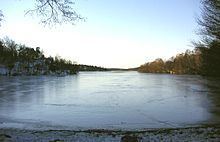 | ||
Vinterviken ("Winter-cove") is a bay in the Mälaren lake in southern Stockholm, Sweden. Vinterviken is located in a valley surrounded by the Gröndal and Aspudden suburb areas. The origin of the name Vinterviken can be traced back to the 17th century. Back then a common winter route (on the lake ice) used to go from Fittja and the Mälaren islands, and entered the city through Vinterviken and lake Trehörningen (nowadays named Trekanten).
Contents
- Map of Vinterviken HC3A4gersten Liljeholmen Stockholm Sweden
- Historical and Cultural area
- Alfred Nobels Factory
- Recreation Area
- Environmental Pollution
- Vinterviken through history
- References
Map of Vinterviken, H%C3%A4gersten-Liljeholmen, Stockholm, Sweden
Historical and Cultural area
Vinterviken has gone through major changes during history since it has transformed from being a vital industrial area to a recreational region. However, the most important stage was when Alfred Nobel, a Swedish chemist, established his new research lab and factory in Vinterviken. In his lab, Nobel invented an enormous revolution for armaments and explosive manufacturing, Dynamite.
Alfred Nobel’s Factory
Alfred Bernhard Nobel bought the whole area of Vinterviken in 1865. Due to safety issues he moved his research lab and his factory (Nitroglycerin Aktiebolaget) from a populated area in Stockholm to Vinterviken which was surrounded by cliffs and was therefore very suitable for the dangerous exploits of Nobel. Gradually, Alfred developed the area by constructing a local rail-road, a harbour, testing grounds/tunnels (Nobel's Spränggroparna) for exploring dynamite and also, housing for factory workers. Dynamite used to be manufactured in this area until 1921 but Nobel's factory remained working until the 1980s.
Recreation Area
Nowadays this place is not used for industrial purposes anymore. Since 1974 Stockholm city owns the Vinterviken region and by renovating this area has converted it from an industrial place to a public recreational area. A major reconstruction in the beginning of the 1990s provided the park with sculptures, walking paths, small gardens, restaurants and a cafe. One of the Nobel factory buildings has become a pleasant banquet hall called "Winterviken".In the area are several places to swim among cliffs and pebbled shores. Vinterviken park, also offers boating and canoeing services.
Leisure Activities in Vinterviken
Environmental Pollution
The industrial activities in the Vinterviken since the 1860s have led to severe soil contamination in the area, with high levels of Lead and Arsenic. It was ranked in 2011 by the City of Stockholm as the ninth most polluted area in the city.
Unusually high levels of uranium have also been detected in the cove's bottom sediment, likely owing to the activities of a nuclear technology company which was previously residing in the area; however, the actual levels of radioactivity are considered low enough not to be considered a health risk.
Vinterviken through history
Vinterviken:
